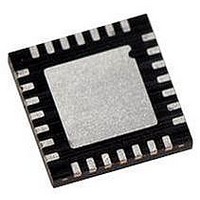PIC18F26K22-I/ML Microchip Technology, PIC18F26K22-I/ML Datasheet - Page 285

PIC18F26K22-I/ML
Manufacturer Part Number
PIC18F26K22-I/ML
Description
IC PIC MCU 64KB FLASH 28QFN
Manufacturer
Microchip Technology
Series
PIC® XLP™ 18Fr
Datasheets
1.PIC16F722-ISS.pdf
(8 pages)
2.PIC18F26J13-ISS.pdf
(496 pages)
3.PIC18F24K22-ISP.pdf
(494 pages)
Specifications of PIC18F26K22-I/ML
Core Size
8-Bit
Program Memory Size
64KB (32K x 16)
Core Processor
PIC
Speed
64MHz
Connectivity
I²C, SPI, UART/USART
Peripherals
Brown-out Detect/Reset, HLVD, POR, PWM, WDT
Number Of I /o
24
Program Memory Type
FLASH
Eeprom Size
1K x 8
Ram Size
3.8K x 8
Voltage - Supply (vcc/vdd)
1.8 V ~ 5.5 V
Data Converters
A/D 19x10b
Oscillator Type
Internal
Operating Temperature
-40°C ~ 85°C
Package / Case
28-VQFN Exposed Pad
Controller Family/series
PIC18
No. Of I/o's
25
Eeprom Memory Size
1KB
Ram Memory Size
3896Byte
Cpu Speed
64MHz
No. Of Timers
7
Lead Free Status / RoHS Status
Lead free / RoHS Compliant
Available stocks
Company
Part Number
Manufacturer
Quantity
Price
Company:
Part Number:
PIC18F26K22-I/ML
Manufacturer:
MICROCHIP
Quantity:
3 400
Part Number:
PIC18F26K22-I/ML
Manufacturer:
MICROCHIP/微芯
Quantity:
20 000
- Current page: 285 of 494
- Download datasheet (6Mb)
16.4
Synchronous serial communications are typically used
in systems with a single master and one or more
slaves. The master device contains the necessary
circuitry for baud rate generation and supplies the clock
for all devices in the system. Slave devices can take
advantage of the master clock by eliminating the
internal clock generation circuitry.
There are two signal lines in Synchronous mode: a
bidirectional data line and a clock line. Slaves use the
external clock supplied by the master to shift the serial
data into and out of their respective receive and
transmit shift registers. Since the data line is
bidirectional, synchronous operation is half-duplex
only. Half-duplex refers to the fact that master and
slave devices can receive and transmit data but not
both simultaneously. The EUSART can operate as
either a master or slave device.
Start and Stop bits are not used in synchronous
transmissions.
16.4.1
The following bits are used to configure the EUSART
for Synchronous Master operation:
• SYNC = 1
• CSRC = 1
• SREN = 0 (for transmit); SREN = 1 (for receive)
• CREN = 0 (for transmit); CREN = 1 (for receive)
• SPEN = 1
Setting the SYNC bit of the TXSTAx register configures
the device for synchronous operation. Setting the CSRC
bit of the TXSTAx register configures the device as a
master. Clearing the SREN and CREN bits of the
RCSTAx register ensures that the device is in the
Transmit mode, otherwise the device will be configured
to receive. Setting the SPEN bit of the RCSTAx register
enables the EUSART. If the RXx/DTx or TXx/CKx pins
are shared with an analog peripheral the analog I/O
functions must be disabled by clearing the corresponding
ANSEL bits.
The TRIS bits corresponding to the RXx/DTx and
TXx/CKx pins should be set.
16.4.1.1
Synchronous data transfers use a separate clock line,
which is synchronous with the data. A device configured
as a master transmits the clock on the TXx/CKx line. The
TXx/CKx pin output driver is automatically enabled when
the EUSART is configured for synchronous transmit or
receive operation. Serial data bits change on the leading
edge to ensure they are valid at the trailing edge of each
clock. One clock cycle is generated for each data bit.
Only as many clock cycles are generated as there are
data bits.
2010 Microchip Technology Inc.
EUSART Synchronous Mode
SYNCHRONOUS MASTER MODE
Master Clock
Preliminary
16.4.1.2
A clock polarity option is provided for Microwire
compatibility. Clock polarity is selected with the CKTXP
bit of the BAUDCONx register. Setting the CKTXP bit
sets the clock Idle state as high. When the CKTXP bit
is set, the data changes on the falling edge of each
clock and is sampled on the rising edge of each clock.
Clearing the CKTXP bit sets the Idle state as low. When
the CKTXP bit is cleared, the data changes on the
rising edge of each clock and is sampled on the falling
edge of each clock.
16.4.1.3
Data is transferred out of the device on the RXx/DTx
pin. The RXx/DTx and TXx/CKx pin output drivers are
automatically enabled when the EUSART is configured
for synchronous master transmit operation.
A transmission is initiated by writing a character to the
TXREGx register. If the TSR still contains all or part of
a previous character the new character data is held in
the TXREGx until the last bit of the previous character
has been transmitted. If this is the first character, or the
previous character has been completely flushed from
the TSR, the data in the TXREGx is immediately trans-
ferred to the TSR. The transmission of the character
commences immediately following the transfer of the
data to the TSR from the TXREGx.
Each data bit changes on the leading edge of the
master clock and remains valid until the subsequent
leading clock edge.
16.4.1.4
The polarity of the transmit and receive data can be
controlled with the DTRXP bit of the BAUDCONx
register. The default state of this bit is ‘0’ which selects
high true transmit and receive data. Setting the DTRXP
bit to ‘1’ will invert the data resulting in low true transmit
and receive data.
Note:
PIC18(L)F2X/4XK22
The TSR register is not mapped in data
memory, so it is not available to the user.
Clock Polarity
Synchronous Master Transmission
Data Polarity
DS41412A-page 285
Related parts for PIC18F26K22-I/ML
Image
Part Number
Description
Manufacturer
Datasheet
Request
R

Part Number:
Description:
Manufacturer:
Microchip Technology Inc.
Datasheet:

Part Number:
Description:
Manufacturer:
Microchip Technology Inc.
Datasheet:

Part Number:
Description:
Manufacturer:
Microchip Technology Inc.
Datasheet:

Part Number:
Description:
Manufacturer:
Microchip Technology Inc.
Datasheet:

Part Number:
Description:
Manufacturer:
Microchip Technology Inc.
Datasheet:

Part Number:
Description:
Manufacturer:
Microchip Technology Inc.
Datasheet:

Part Number:
Description:
Manufacturer:
Microchip Technology Inc.
Datasheet:

Part Number:
Description:
Manufacturer:
Microchip Technology Inc.
Datasheet:











